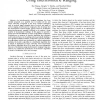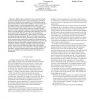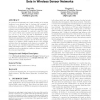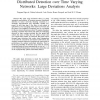155 search results - page 21 / 31 » Formal Theory of Noisy Sensor Network Localization |
ICC
2007
IEEE
14 years 1 months ago
2007
IEEE
— An interferometric ranging technique has been recently proposed as a possible way to localize ad hoc and sensor networks. Compared to the more common techniques such as receive...
TMC
2012
11 years 10 months ago
2012
— While many protocols for sensor network security provide confidentiality for the content of messages, contextual information usually remains exposed. Such information can be c...
MOBIHOC
2008
ACM
14 years 7 months ago
2008
ACM
A Connected Dominating Set (CDS) working as a virtual backbone is an effective way to decrease the overhead of routing in a wireless sensor network. Furthermore, a kConnected m-Do...
CORR
2010
Springer
13 years 6 months ago
2010
Springer
—We apply large deviations theory to study asymptotic performance of running consensus distributed detection in sensor networks. Running consensus is a stochastic approximation t...
PODC
2005
ACM
14 years 1 months ago
2005
ACM
Many large-scale networks such as ad hoc and sensor networks, peer-to-peer networks, or the Internet have the property that the number of independent nodes does not grow arbitrari...




